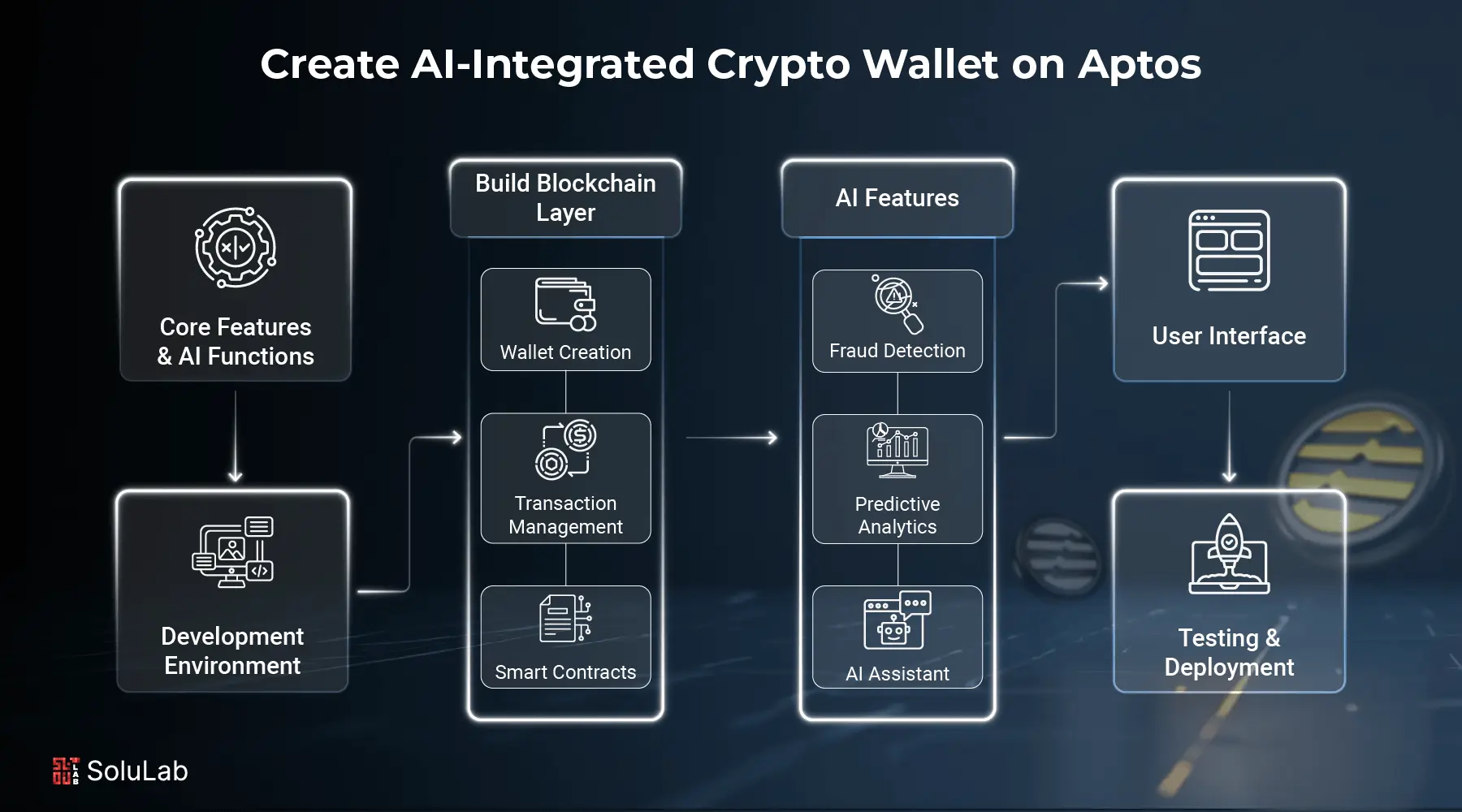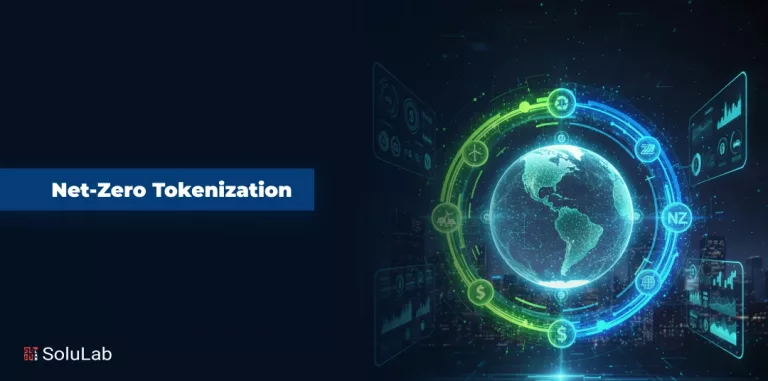
A crypto wallet that does more than just store your tokens?
It learns from how you spend your money, helps you make better choices, and keeps your assets safe with smart AI defenses. That’s not some idea from the future. It’s going on now!
With the rise of smart wallets and intelligent dApps, creating a coin wallet with AI on the Aptos blockchain has become a great opportunity for developers, companies, and Web3 pioneers.
So why Aptos? Due to the fact that it is quick, safe, and designed to be expandable. Aptos can handle more than 160,000 transactions per second (TPS) at the moment thanks to its parallel processing engine. Its Total Value Locked (TVL) went over $1.03 billion in March 2025, a big jump from the previous months. This growth shows that the site can grow and that people in the crypto world trust it.
In this blog, we’ll take you step-by-step through the process of developing an AI-integrated cryptocurrency wallet on the Aptos blockchain, covering everything from smart contract deployment to embedding intelligent algorithms that make your wallet smarter, safer, and more user-centric. So, let’s get started!
Why Choose the Aptos Blockchain for Building a Crypto Wallet?
Aptos is a powerful and future-oriented blockchain that excels in performance, scalability, and developer experience, making it a prime choice for developing a next-gen crypto wallet. The architecture, constructed with the Move programming language, provides improved safety and upgradability, rendering it suitable for contemporary wallet applications. If you intend to create an AI cryptocurrency wallet application, these are the reasons Aptos is the optimal selection:
- High Throughput & Low Latency: Aptos ensures quick and effective wallet operations by processing thousands of transactions per second with sub-second finality.
- Smart Contracts Using Move Language: Move reduces vulnerabilities typical of other blockchain ecosystems since it was designed with safety and adaptability in mind.
- Upgradability Without Downtime: Aptos’s modular design and on-chain updates make it ideal for wallets that gradually include new AI functions.
- Parallel Execution Engine: Your AI crypto wallet app on Aptos can manage high volumes without experiencing obstacles because to Aptos’ use of parallel transaction processing (Block-STM).
- Developer-Friendly Ecosystem: Development is simplified and time-to-market is decreased via robust SDKs, unambiguous documentation, and active tooling support.
- Strong Community & Backing: Aptos has a thriving developer ecosystem and strong institutional backing, which guarantees its longevity and ongoing innovation.
- Designed for Smart Integration: Aptos is the best option for safely and effectively integrating AI capabilities, whether you’re adding biometric login, AI transaction classification, or fraud detection.
With the help of Aptos’ modern abilities, developers can provide a wallet experience that is intelligent, safe, and seamless, ideal for consumers exploring the dynamic Web3 ecosystem.
Essential Features of an AI-Enhanced Crypto Wallet on Aptos
When developing an AI-enhanced cryptocurrency wallet on the Aptos blockchain, it is essential to incorporate distinctive characteristics that differentiate it from traditional wallets. The essential AI crypto wallet features are as follows:
-
AI-Driven Wallet Setup
The initial duty for users is to establish a wallet, either using a mnemonic phrase or by importing a pre-existing private key. AI may advance by providing automatic recovery alternatives in the event of access loss, significantly improving both security and user experience.
-
Better Transactional Features
The principal function of any cryptocurrency wallet is to oversee digital assets. Utilizing AI, your wallet may categorize and label transactions according to their kind (e.g., payment, trade, transfer). Furthermore, AI may aid users in overseeing many wallets or accounts, offering recommendations on the appropriate wallet for each particular transaction.
-
Smart Portfolio Administration
AI may function as a portfolio manager, providing real-time research and tailored recommendations based on market trends, asset volatility, and the user’s risk appetite. Leveraging market signals, AI may recommend modifications to a user’s portfolio to maintain balance and optimize for maximal returns.
-
Intelligent AI Assistant
An integrated AI assistant may respond to consumer inquiries, supply market data, and perform transactions based on speech or text commands. This AI-driven assistant streamlines wallet engagement, facilitating navigation within the cryptocurrency domain for users, even novices.
-
Multi-Currency and Cross-Chain Interoperability
An AI-integrated cryptocurrency wallet on Aptos may accommodate assets from many blockchains, providing a multi-chain wallet development experience. This functionality enables users to handle Aptos tokens as well as tokens from other blockchains, like Ethereum, Binance Smart Chain, and Solana.
By integrating these essential elements, many AI development companies can create an AI-enhanced cryptocurrency wallet distinguished by its user-friendliness, security, and multi-chain compatibility, rendering it appropriate for both rookie and seasoned cryptocurrency users.
Read Also: Why Every Business Should Integrate POS Crypto Wallets?
The Role of AI in Crypto Wallet App

The use of artificial intelligence in cryptocurrency wallet applications enhances both security and user experience substantially. Through the integration of AI, developers may provide a more intuitive, efficient, and safe method for consumers to handle their bitcoins. AI is revolutionizing cryptocurrency wallets.
- Enhanced Security: AI assists in detecting suspicious behaviors and possible fraud by perpetually monitoring transactions and highlighting anomalous trends in real time.
- Customized Experience: AI evaluates a user’s transaction history and preferences, providing individualized suggestions for cryptocurrency investments and transaction decisions.
- Task Automation: AI can automate certain wallet operations, like as performing trades or modifying a portfolio, therefore conserving time and minimizing human mistakes.
- Fraud Prevention: By identifying anomalous behavior or activities, AI provides an extra layer of protection, preventing unlawful access to cash or assets.
- Portfolio Insights: AI offers critical analysis of portfolio performance, enabling users to make educated investment choices and modify strategies accordingly.
For enterprises pursuing AI crypto wallet development, the incorporation of intelligent features may enhance both security and user engagement. Furthermore, for individuals intending to start a cryptocurrency exchange, artificial intelligence may optimize operations such as trade execution and market research.
Step-by-Step Process of Creating an AI-Integrated Crypto Wallet on Aptos
Let’s break down the process of developing a crypto wallet on the Aptos blockchain with integrated AI features. Below are the key steps to follow when building this innovative wallet solution.
Step 1: Outline Core Features and AI Functions
Before starting the development process, it’s important to define the main features your wallet will have. Think about adding AI features like fraud detection, personalized portfolio recommendations, or even a virtual assistant. Decide if your wallet will support only Aptos or include multi-chain capabilities for additional blockchain support.
Step 2: Set Up the Development Environment
The next step is to set up your development environment for Aptos. Begin by installing the Aptos CLI (Command Line Interface), and configure your local setup. Choose the programming language you’ll be using, such as Python, JavaScript, or Rust. You’ll also need to integrate Move, which is the language for developing smart contracts on Aptos.
Step 3: Build the Blockchain Layer
Your wallet will need to interact with the Aptos blockchain. Here’s what you’ll work on in this stage:
- Wallet Creation: Enable users to create wallets and securely store private keys.
- Transaction Management: Allow users to send and receive tokens, view balances, and track transaction history.
- Smart Contracts: Develop smart contracts using Move to add custom features to your wallet.
Step 4: Add AI Features
Once the basic wallet structure is in place, it’s time to add AI capabilities to improve the user experience:
- Fraud Detection: Use machine learning to spot unusual transactions, preventing unauthorized access or fraud.
- Predictive Analytics: The Use of predictive analytics offers users market trend insights and personalized suggestions based on their activity and preferences.
- AI Assistant: Incorporate a virtual assistant to help users with tasks like making transactions, answering questions, and providing support.
Step 5: Design the User Interface (UI)
The UI should be intuitive and easy to navigate. Choose frameworks like React for web applications or Flutter for mobile apps to ensure the wallet is responsive and user-friendly.
Step 6: Testing and Deployment
After building the wallet, it’s crucial to test it on the Aptos testnet to ensure everything works smoothly. Once you’ve resolved any bugs, deploy your wallet to the Aptos mainnet for public use.
Aptos wallets provide users with a seamless and secure experience in managing their digital assets. By following these steps, you can create a wallet on Aptos that not only allows users to manage their assets efficiently but also utilizes the power of an AI assistant to offer an enhanced, personalized experience.
Read Also: Blockchain Interoperability For Enterprise Adoption
Costs of Developing an AI-Integrated Crypto Wallet
Developing an AI-integrated crypto wallet involves several stages, and each comes with its own set of costs. Below is a breakdown of the typical costs involved in the development process:
| Development Stage | Estimated Cost Range | Description |
| Planning and Research | $5,000 – $15,000 | Includes research on features, AI integration, and blockchain compatibility. |
| UI/UX Design | $10,000 – $30,000 | Design of the user interface and user experience, ensuring ease of use and visual appeal. |
| Blockchain Integration | $15,000 – $50,000 | Setting up the blockchain layer and integrating it with the crypto wallet (e.g., Aptos, Ethereum). |
| AI Integration | $20,000 – $60,000 | Integrating AI features like fraud detection, predictive analytics, and AI-powered assistants. |
| Security Measures (2FA, Encryption) | $10,000 – $25,000 | Implementing security protocols such as two-factor authentication and data encryption to protect assets. |
| Smart Contract Development | $15,000 – $40,000 | Developing custom smart contracts on blockchain for secure transactions and wallet management. |
| Testing and QA | $5,000 – $15,000 | Rigorous testing to ensure all features work properly and the app is secure before going live. |
| Deployment | $10,000 – $20,000 | Deploying the crypto wallet on the blockchain, ensuring it’s live and accessible for users. |
| Maintenance and Updates | $5,000 – $15,000 annually | Ongoing support for bug fixes, security updates, and introducing new features. |
Conclusion
In conclusion, building an AI-integrated crypto wallet on the Aptos blockchain offers a unique way to enhance user experience, security, and functionality. By leveraging AI, wallet apps can provide users with automated services like fraud detection, predictive insights, and a more intuitive interface.
At SoluLab, we assist as a leading crypto wallet development company by providing custom solutions tailored to meet specific needs. With our expertise in both blockchain and AI, we support businesses in creating highly secure and efficient wallets that stand out in the competitive crypto space.
One of our standout projects is DLCC, which aims to change the future of regulated crypto and digital asset lending. SoluLab developed a decentralized blockchain-based solution for the financial sector, including a crypto wallet that simplifies borrowing and lending.
Ready to take the next step in your crypto wallet development journey? Reach out to SoluLab today and let us help you to get started!
FAQs
1. What is an AI-integrated crypto wallet?
An AI-integrated crypto wallet combines traditional wallet functionalities with artificial intelligence to enhance the user experience. It typically uses AI for fraud detection, automated portfolio management, transaction categorization, and sometimes even provides a virtual assistant to interact with the wallet.
2. How does AI improve the security of a crypto wallet?
AI improves wallet security by analyzing transaction patterns and detecting suspicious activity in real-time. Through machine learning, it can identify irregular behavior, such as unauthorized transactions or potential fraud, and alert the user before any damage is done.
3. What are the benefits of using an AI-powered portfolio management system in a crypto wallet?
AI-powered portfolio management helps users optimize their investments by analyzing market trends, historical data, and personal preferences. The system can provide real-time insights into asset performance and suggest portfolio adjustments based on market fluctuations, helping users make smarter, data-driven decisions without the need for constant monitoring.
4. Can I integrate multiple cryptocurrencies into an AI-integrated wallet?
Yes, many AI-integrated wallets support multiple cryptocurrencies, including Bitcoin, Ethereum, and various altcoins. This multichain capability allows users to manage a diverse range of digital assets in one place, making it easier to store, send, and receive cryptocurrencies from different blockchains within a single wallet.
5. How can AI assist new users in understanding how to use a crypto wallet?
AI can provide new users with a more accessible and guided experience. Through virtual assistants or chatbots, users can ask questions and receive instant responses, which helps them understand wallet functions, complete transactions, and learn about security practices. AI can also suggest steps to improve wallet usage and guide users through more complex processes, reducing the learning curve for beginners.






